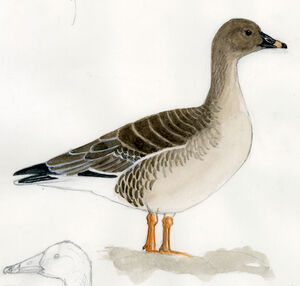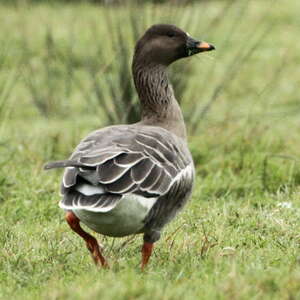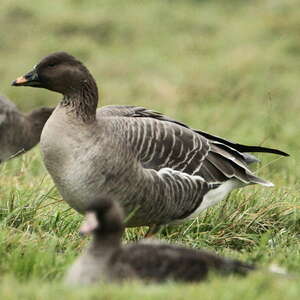Tundra Bean Goose
Anser serrirostris - Oie de la toundra
Identification
The taxon Bean Goose has evolved a lot. Originally, it grouped in subspecies all of the morphs showing approximately the same characteristics, a black and orange (or pink for one of them) beak and orange legs. After quite a few mishaps, the current situation is as follows. The taxon gave birth to 3 species, Bean Goose itself, Tundra Bean Goose and the Greylag Goose. Here we will focus on the second one, Anser serrirostris. This one has two subspecies, the rossicus in the west and the nominative serrirostris in the east.
The Tundra Bean Goose of the rossicus subspecies is close in appearance to the western subspecies fabalis of Bean Goose, and the distinction is not obvious, especially with single individuals. Moreover, the two taxons can winter side by side. They have approximately the same size but the appearance is slightly different. In rossicus, the head-neck area is of a dark brown which contrasts better with the rest of the plumage. The neck is slightly shorter and the beak too, and more stocky. The beak is particularly important. It is high at the base and relatively short, triangular looking from the profile. It has a straight culmen, rarely very slightly convex. It is black with just a fairly narrow orange subterminal ring, yet even some fabalis have this too. It is therefore the beak's morphology which is decisive. Sometimes, a bit of white marks the outline of the beak base. The eye is dark and the legs are bright orange. The sexes are similar.
In the juvenile, the beak ring is indistinct and the legs are dull.
Subspecific information 2 subspecies
- Anser serrirostris serrirostris (ne Siberia)
- Anser serrirostris rossicus (n Russia, nw Siberia)
Foreign names
- Oie de la toundra,
- Ánsar campestre de la tundra,
- ganso-da-tundra,
- Tundrasaatgans,
- Toendrarietgans,
- Oca granaiola della tundra,
- tundrasädgås,
- Tundrasædgås,
- hus tundrová,
- husa tundrová,
- Tundrasædgås,
- oca de la Tundra,
- gęś tundrowa,
- tundras sējas zoss,
- Тундровый гуменник,
- 短嘴豆雁,
- 凍原豆雁,
Voice song and call
The call is very close to that of the Barnacle Goose, perhaps with a slightly higher tone. It's not discriminatory.
Habitat
The Tundra Bean Goose breeds on the shores of arctic lakes and rivers, in the tundra and at the edge of taiga. It winters in the southern part of the continent in wetlands, prairies and agricultural land. It greatly appreciates free access to fresh water. The eastern subspecies also appreciates rice fields.
Dietfeeding habits
The Tundra Bean Goose feeds year-round on plants and their seeds or fruits as well as their storage organs. Grasses play a big role in the summertime, and Ericaceae berries in summer. In wintering grounds, grasses from meadows, young cereals (which is not to the farmers' liking), seeds (cereals, peas, beans) left on the ground in fields, fleshy roots (carrots, beets) and unharvested tubers (potatoes) suit them just fine. Birds from the east also add rice to their menu.
Reproduction nesting
Birds arrive late to their Arctic breeding grounds at the end of May. Nesting then takes place in June-July.
The species is monogamous and it seems that couples remain together for the long term. The couple settles in a dry section of tundra known as a hummock, close to wet areas such as wide glacial valleys where they can feed. The nest is a bundle of vegetation lined with down in the central cup. The female deposits 4-6 (3-8) eggs which she incubates for about 4 weeks. The chick is covered in a reddish-brown down. Its beak and feet are gray. The young fledge several weeks later, although exactly how many is not known. Reproductive success is very variable depending on environmental conditions. In years without lemmings, the majority of the nests are destroyed by Arctic foxes.Geographic range
The Tundra Bean Goose breeds along the length of Russian tundra. There is recent evidence of its nesting in Finnmark, which constitutes a progression. The wintering areas of the two ssp are disjoint. Rossicus comes to winter in Western Europe and Central Europe while serrirostris targets northeast China, the Korean peninsula and Japan.
Threats - protection
IUCN conservation status
concern
in the Wild
threatened
evaluated
Birdlife International does not yet recognize this taxon. This Tundra Bean Goose does not appear to be threatened at the moment. In fact, it is even increasing to the West. The rossicus subspecies is favored in its European wintering zone by the modern crop rotations practiced there.
Sources of information
- IOC World Bird List (v15.1), Gill, F and D Donsker (Eds). 2025-12-07.
- Canards, cygnes et oies d'Europe, d'Asie et d'Amérique du Nord, Reeber Sébastien
- Ducks, Geese and Swans, Kear, J
- Guide des canards, des oies et des cygnes, Steve Madge
- Les palmipèdes d'Europe, Géroudet P., MAJ M. Cuisin
- Wildfowl: An identification guide to the ducks geese and swans of the world, Madge, S and Burn, H
- Birds of the World, The Cornell Lab of Ornithology
- xeno-canto, Sharing bird sounds from around the world,
Other sources of interest
 Specification sheet created on
27/07/2023 by Jean François
Specification sheet created on
27/07/2023 by Jean FrançoisTranslation by AI Oiseaux.net
© 1996-2026 Oiseaux.net
- Accipitriformes
- Aegotheliformes
- Anseriformes
- Apodiformes
- Apterygiformes
- Bucerotiformes
- Caprimulgiformes
- Cariamiformes
- Casuariiformes
- Charadriiformes
- Ciconiiformes
- Coliiformes
- Columbiformes
- Coraciiformes
- Cuculiformes
- Eurypygiformes
- Falconiformes
- Galliformes
- Gaviiformes
- Gruiformes
- Leptosomiformes
- Mesitornithiformes
- Musophagiformes
- Nyctibiiformes
- Opisthocomiformes
- Otidiformes
- Passeriformes
- Pelecaniformes
- Phaethontiformes
- Phoenicopteriformes
- Piciformes
- Podargiformes
- Podicipediformes
- Procellariiformes
- Psittaciformes
- Pterocliformes
- Rheiformes
- Sphenisciformes
- Steatornithiformes
- Strigiformes
- Struthioniformes
- Suliformes
- Tinamiformes
- Trogoniformes





















